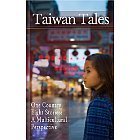Patrick Wayland's Blog, page 2
May 16, 2015
Diving Longdong Fishing Harbor
About forty minutes north of Taipei and east of the port city of Keelung, is Longdong Harbor. It sits at the northeast point of Taiwan, among a few fishing villages and narrow channels where boats are berthed on calm, green water. The boats are for squid and have basketball-sized light bulbs strung across their riggings. These giant lights attract the squid at night and from a distance light-up the boats like cities on a continent.
To beat the crowds, we arrived early with our guide, Mr. Lee. Longdong is a hotspot for SCUBA diving, perhaps the best spot in north Taiwan. Mr. Lee is an expert, knows the place like his backyard. He’s in his fifties and has been diving for thirty years. He’s been just about everywhere in Asia. Maldives, The Phillipies, Palau… He tells us the deepest he has ever dived is 360 feet (110 meters) and has never had the bends, or decompression sickness – a real risk when doing dives deeper than 65 feet (20 meters) meters.
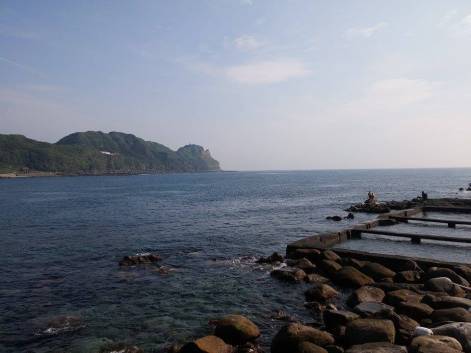
Longdong Harbor
We stop in Longdong village to rent air tanks. It’s a small place, but caters to the sport. There are a couple shops for divers and a few restaurants. After we load our tanks, we drive down a narrow road along the jetty, passing women tossing seaweed on areas of pavement. To harvest seaweed, it must be dried.
After suiting-up, we step into the harbor off a jetty ledge. The water is cool and calm, but a little dusty. Visibility is around 30 feet. The bottom is a mix of reef, sand, and boulders. There’s plenty of tropical fish. Right away, we see blue tang, needle fish, lion fish, sea urchins, and puffer fish. Mr. Lee reaches out and takes hold of a puffer and we get to see it in its ballooned state, spikes fully extended. The puffer’s fins flap away in a blur, inadequate for its inflated form. It slowly turns and moves away from us like a balloon released into the air. When it’s out of reach, it deflates itself – to swim away faster. There’s a wreck toward the middle of the harbor, but it’s just angular pieces of whatever vessel it once was. It’s now completely coated in plant life and looks just like a rock at first glance. A closer inspection reveals the square catacombs of some superstructure.
As we make our way back to the jetty, we run into a long cloud of minnows. It runs like a banner across our field of view. It takes a minute for the school to finish passing. The silver minnows glitter in sunlight above. I watch as my exhaled bubbles rise up to escape that atmosphere.
One of the best parts of the trip is the ride along the north coast to Keelung. It’s mountainous and green on one side and blue ocean on the other. We pass an abandoned gold mill that I mistook for a fort. Mr. Lee talks about marriage and the right age a man should be for it – about 40 in his opinion. Mr. Lee always stops in Keelung to buy dumplings from one particular shop. And for the life of me, I don’t know the difference. There are a million of these dumpling shops in Taiwan.
We head back to Taipei and pass the ship channel, passing hundreds of stacked steel containers and the cruise terminal where one can board a ship to Japan if one so desires. It’s Saturday and the sky is blue.


December 5, 2014
Roger Jergenson’s Flyout
Check out my latest short story “Roger Jergenson’s Flyout” in the anthology Taiwan Tales – One Country, Eight Stories: A Multicultural Perspective.
When a burned-out American baseball player is offered a chance to play for a team in Taiwan,he gets one last chance to redeem himself on the field and learn why his life has gone so wrong.

December 4, 2014
Writing by Hand Vs. Typing
In a recent interview, Tom Wolf, author of The Bonfire of the Vanities and perpetual wearer of white suits, described how he hand writes his novels(!). That’s right, he uses a pen – or mechanical pencil – and writes in a notebook with triple-spaced lines. He doesn’t stop until he finishes his goal of 1200 words per day. A writer friend of mine, while holding her Moleskine, mentioned that many writers like Joyce Carol Oates and Amy Tan also start their novels using longhand. Of course old school writers like Hemingway wrote a lot more in notebooks, but he also rode a lot more horses. Today we drive cars.
Why in the world would I write by hand when I have my laptop that practically writes the book for me with software that checks spelling, grammar and English proficiency level (Spell Checker just told me to correct ‘profeciency’). I can now type a hundred miles per hour and go from sentence to paragraph to page to story in a single NaNoWri Month. Why would I want to slow myself down? Why would I care about that arcane skill of penmanship? But when it comes to relying on technology, I’m reminded of those important words of wisdom…
“Don’t be too proud of this technological terror you’ve constructed. The ability to destroy a planet is insignificant next to the power of the force.” –Darth Vader
Like wielding a lightsaber, wielding a pen takes a great deal of patience and effort to use. I haven’t written any novels in notebooks, but I do use them for ideas, sections, short stories and outlines. There is something to say of using a notebook. I can take my notebook almost anywhere. Like on an airplane. (Have you tried using a laptop in an airline seat lately?) Or at the beach. Or reclining on the couch.
Using a pen and notebook also helps me disconnect. When I’m using my laptop, here’s my thought process. Oh boy!, I’m really ready to do some writing. Let me check my email first. What’s this? A Facebook message from Larry. He says to checkout out this Youtube video. Oh, those cats are so cute. I can’t believe someone wrote those bad things in the video comments. I’m gonna reply, defending this and all cat videos… I start my writing two hours later.
Using a pen also slows down my actions. It forces me to stop and smell the proses. It forces me to spend more time considering my words. When I use a laptop, I can form the words on page as soon as they emerge in my mind. But when I use a pen, I’m considering the entire sentences before I move my hand, and this means less revisions. The drawback, of course, is I still need to transfer everything to computer, but I’m not sure I lose time given more revisions are needed for a quickly built story.
So, how do you like to write? Pen, keyboard, that dictating stone-pecking bird from the Flintstones?

November 21, 2014
Harvard Classic e-books free!
When I have a little money, I buy books; and if I have any left, I buy food and clothes.
― Desiderius Erasmus
openculture.com has over 600 Harvard Classic e-books that can be downloaded for Free!

October 28, 2014
I don’t even pause from writing to choose the right word or to verify spelling
From a 1963 essay by Ian Fleming on his writing habits:
I write for about three hours in the morning – from about 9:30 till 12:30 and I do another hour’s work between six and seven in the evening. At the end of this I reward myself by numbering the pages and putting them away in a spring-back folder. The whole of this four hours of daily work is devoted to writing narrative.
I never correct anything and I never go back to what I have written, except to the foot of the last page to see where I have got to. If you once look back, you are lost. How could you have written this drivel? How could you have used “terrible” six times on one page? And so forth. If you interrupt the writing of fast narrative with too much introspection and self-criticism, you will be lucky if you write 500 words a day and you will be disgusted with them into the bargain. By following my formula, you write 2,000 words a day and you aren’t disgusted with them until the book is finished, which will be in about six weeks.
I don’t even pause from writing to choose the right word or to verify spelling or a fact. All this can be done when your book is finished.


October 10, 2014
Following the Equator
Following the Equator documents Mark Twain’s journey around the world in 1897 as he visits Australia, Tasmania, New Zealand, India, the island of Mauritius and South Africa. Written at an interesting time, Twain reveals some of the haphazard problems to travel of the day, such as a Hawaiian Cholera outbreak that, regretfully, prevented his boat from letting passengers disembark on the islands.
Twain’s wit and wisdom is on full display in the book as he adds an epigraph atop every chapter – a quote from Pudd’nhead Wilson’s New Calendar :
It is by the goodness of God that in our country we have those three unspeakable precious things: freedom of speech, freedom of conscience, and the prudence never to practice either of them.
He travels extensively around India, stopping around Bombay, Calcutta and Taj Mahal. It is clear that India is one of his favorite places. He loves the legend, the mythology, the dichotomy of it:
This is indeed India! the land of dreams and romance, of fabulous wealth and fabulous poverty, of splendor and rags, of palaces and hovels, of famine and pestilence, of genii and giants and Alladin lamps, of tigers and elephants, the cobra and the jungle, the country of a hundred nations and a hundred tongues, of a thousand religions and two million gods…
In South Africa, he learns about the Boers struggle for independence and visits the De Beers office where raw diamonds are mined, at the time the company was just beginning. Twain was a vocal egalitarian, and he adds in a good deal of criticism of the racism he saw in Australia, India and South Africa. The book is mostly remembered for that, but it is also a great read for its historical perspective on the places he visited as well as the humorous stories and colorful descriptions that only Mark Twain could add.


September 10, 2014
7 Holes Waterfall
Always on the lookout for pristine spot of nature, preferably involving a bit of water, and without busloads of tourist jostling for space or government signs telling you what you cannot do, “7 Holes Waterfall” was a fantastic find, feeling like a place practically undiscovered.
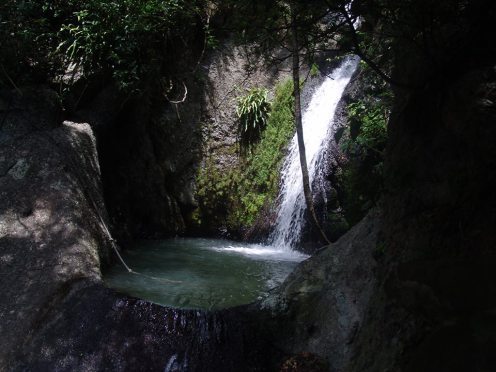
The wife and I stayed in the township of Hengchung, located at the geographical center of the southern peninsula of Taiwan, out of reach of the fast train, but on the highway. Most tourists rush past it, heading to Kenting, the closest thing Taiwan has to a Riviera. Hengchung is a day trip for beachgoers staying at the resorts along the coast, giving them summer options like horseback rides, paintball and a few historic landmarks. Our hotel was across the street from a go-cart track. At the front desk, we asked the clerk to call a taxi since we arrived by bus, and she asked if we wanted to rent a scooter. Yes! At 300NT($10 US) a day, it would give us a great deal of independence as well as convenience. The clerk made a phone call. Twenty minutes later a flat bed truck arrived with our scooter.
We took the only road going east, a two-lane country highway meandering past farm fields and hills. Then one turn onto a smaller road that headed up into the mountain forest. The land before the waterfalls is privately owned, and the homeowner maintains a parking lot big enough for dozens of tour buses. But the parking lot was empty – and on a Sunday! We found the gatekeeper, an eighty-year-old woman, sitting at her custom rock patio table, drinking beer and sitting near her two black mangy dogs that looked about as old. We paid 20NT(60 cents US) for parking and started on the five minute walk up a trail leading to the base of “7 Holes”.
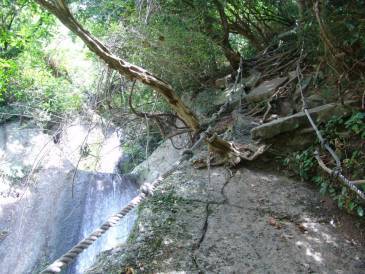
“7 Holes” is a series of steps in a waterfall system. The “holes” are the plunge pools. Because of the thick jungle canvas and how steep the mountain was this was not apparent when we first arrived. It appeared there was only one drop of about 50 feet down the inclined rock. The pool was shallow – only about half a foot deep, blocked by a massive bolder. A rope – knotted every three feet for grip control – tied to the trees up the incline clued us in to the next step. Using the rope, I climbed the steep rock and found the second waterfall. This waterfall was more impressive with a real plunge and so a deeper plunge pool than the base. While we waded in about 3-feet of water, a tour guide arrived with a family of three. The tour guide, a fit man in his fifties, explained that you could spend 8 hours following the trail up to the top. We only climbed up 6 levels. The rope-lined path is quite steep and precarious, a mix of loose rock, ground and tree roots. It’s not for everyone. If you can climb a tall ladder, then you should be able to make the trail following the waterfall system up the mountain.
Some of the plunge pools, carved out by the years, were almost perfect bowls deeper than 5-feet (1.5 meters). I jumped into one pool. The day was cloudless and hot, but the jungle shaded the stream, the water was cool and refreshing. I quickly found that I could not touch bottom with my head above the water. Holding onto the smooth lip where the water spilled over, I looked down to the next level before turning and noticing that I was being watched by two frogs sitting on the side rim. Getting out of this bowl was not simple. I took several tries using a low tree bough and a rope to make it onto inclined ground. A little dangerous. Very worth the visit.
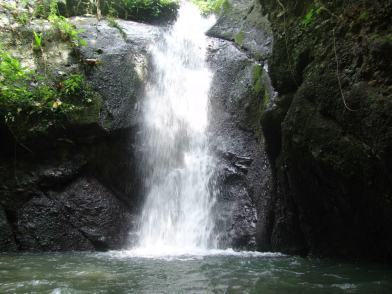


August 29, 2014
The Black-Bearded Barbarian
The Black-Bearded Barbarian tells the story of George Leslie MacKay, the Presbyterian Priest from Canada, who brought Christianity to north Taiwan, or Formosa as it was known in the late 1800’s. Even if you are not a religious person, this book is interesting in showing how one man, alone, walked into a land where he didn’t know the culture or one word of the language and, over time, introduced an idea that change a people.
When MacKay landed, he first went about learning the language, customs and beliefs of the people. Most of the locals did not want to even rent a room to him – wanting only to stone him for being a foreign devil. But MacKay, living in a hut by a river, spent all his time learning Chinese, amazingly mastering it enough after only a few months to read and understand the scholarly texts of the intellectuals. He learned the scholar books so well that he would argue with the mandarins (men from the ruling class). His arguments for his beliefs were logical as well as spiritual. It was one of these bright, young mandarins, so impressed with MacKay’s solid reasoning and unwavering beliefs, who became MacKay’s first convert.
MacKay, with the bravery of “an army”, walked from village to village talking about his beliefs, even traveling into the wild mountains where the Chinese dared not venture because of native headhunters. But he did not just preach, often working as a doctor, performing dentistry and giving out medicine for Malaria relief. He married a local woman and, in the end, was buried in Taiwan. This showing how ingrained he was with the people he had changed.


August 18, 2014
Books: Chita
Old Book Review on manybooks.net: Chita, 1889
Chita, which is short for Conchita(Spanish for girl), is the fictional tale about the actual hurricane that hit Last Island, Louisiana, in 1856. The storm razed a resort hotel and killed over 200 people. In the story, Chita – a 5-year-old girl, survives the storm and is adopted by a Spanish fisherman and his wife. Her father, who later returns to New Orleans, does not know she is still alive and spends his last days in sorrow.
Hearn writes with an ear for language, capturing the different cultures of New Orleans – Spanish, Anglo, French, Italian and Creole – with very authentic dialog.Chita is a simple story, focusing on a simple tragedy while showing how life adjusts to change. The little girl quickly grows into her new home. Going from the city to the fisherman’s cottage, her skin darkens, she becomes quiet and explorative, she learns to read the waters and understand the weather. Hearn’s prose are rich with these natural details that let the reader feel the heat, taste the brine, hear the immigrants, see the storm clouds forming and Chita should be read for this feature.


August 10, 2014
Old Book Reviews
OK, I’ll admit it. I love books like Burgess Meredith in that Twilight Zone episode “Time Enough at Last”. You know the one where the human race has been wiped out and he’s stacking books up to read. So, I’m going to be adding reviews whenever I can about *FREE* stuff I read on manybooks.net. You know that website with *FREE* books. Did I mention *FREE* books?
Today’s Old Book Review:
Rebel Raider, 1950
Rebel Raiders is a very quick read, being a short historical story first published in the magazine True: The Man’s Magazine which has an interesting history itself. True was the first men’s magazine to sell over a million copies a month back when men shaved with ax blades and wrestled bears. And being called “The Man’s Magazine”, you can expect a real man’s tale and that’s what you get.
The story chronicles the service of the Confederate Colonel John Singleton Mosby, aka “The Grey Ghost”. Mosby came up with the idea that an enemy battle front could be pushed back with mounted raids. He quickly proved his point with excursions into northern Virginia, causing Union defense forces to be increased and more patrols to be assigned.
Mosby had a numerous accomplishments. In 1863, he captured Brigadier General Stoughton along with 58 horses. President Lincoln later commented on hearing the news that he was sorry to lose the horses; after all, he could make all the generals he wanted. Even in the waning days of the war when some Confederate states had surrendered, Mosby was raiding cities fully fortified by Union soldiers. His final plan was to sneak into Richmond and capture General Ulysses S. Grant! But just before entering the city, he learned that General Robert E. Lee, his commander, had surrendered. After the war, he supported Grant for president, because, as he said, he had been a soldier. This was not socially acceptable by many Southerners at the time.
Bravery, honor, smarts, grit. Rebel Raiders is a nice read for any red-blooded American boy or anyone who appreciates a good war story.



